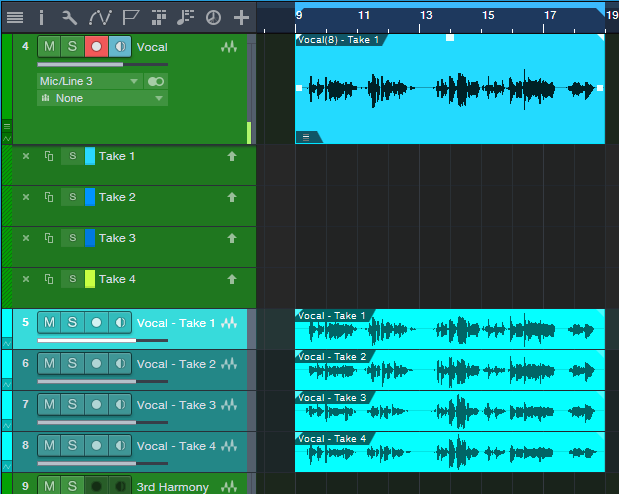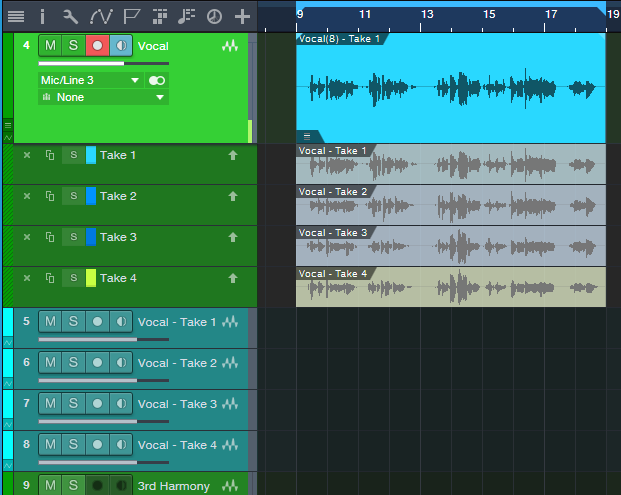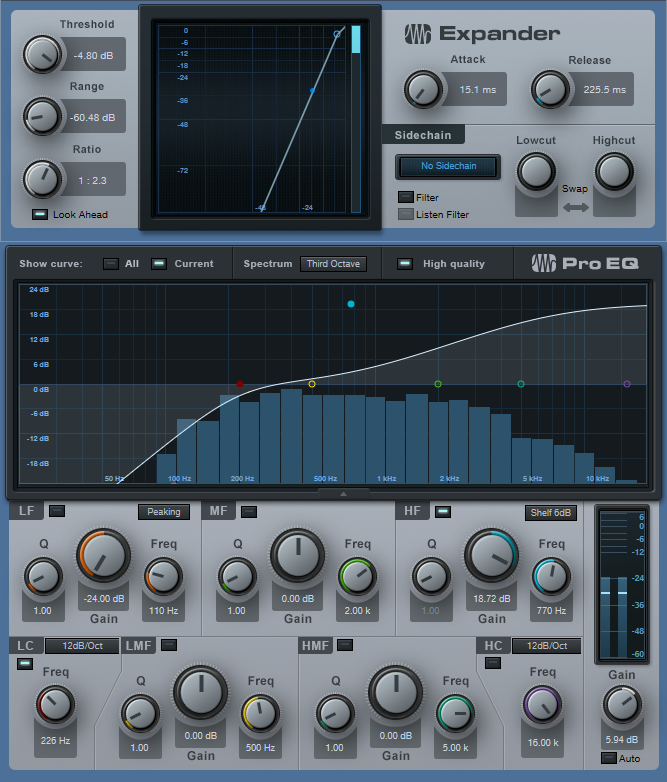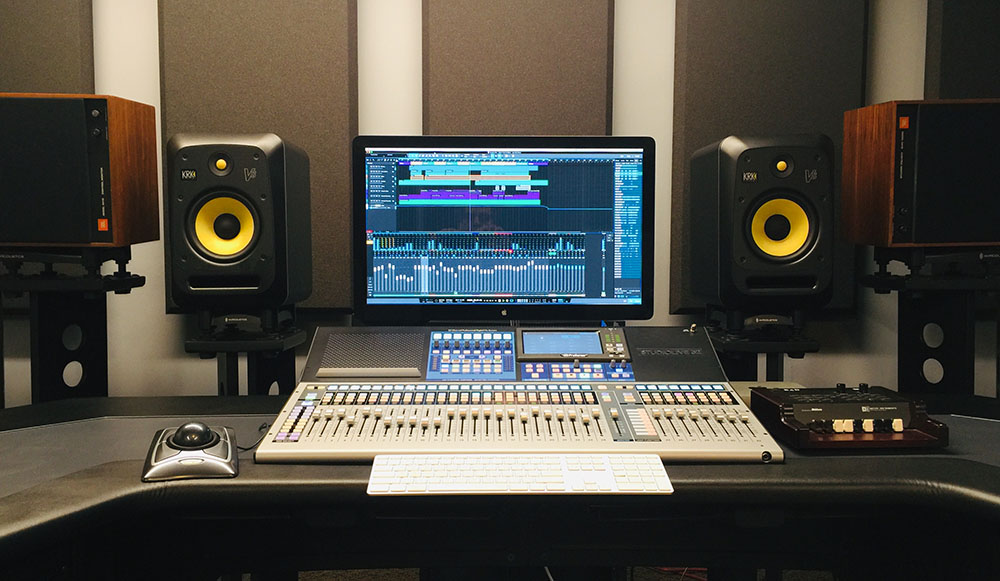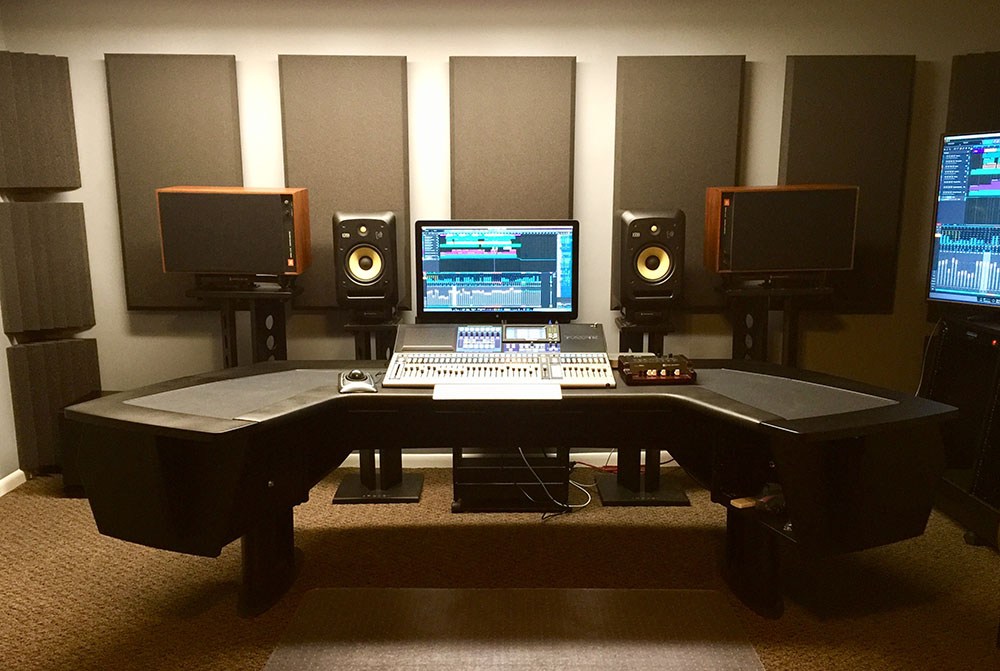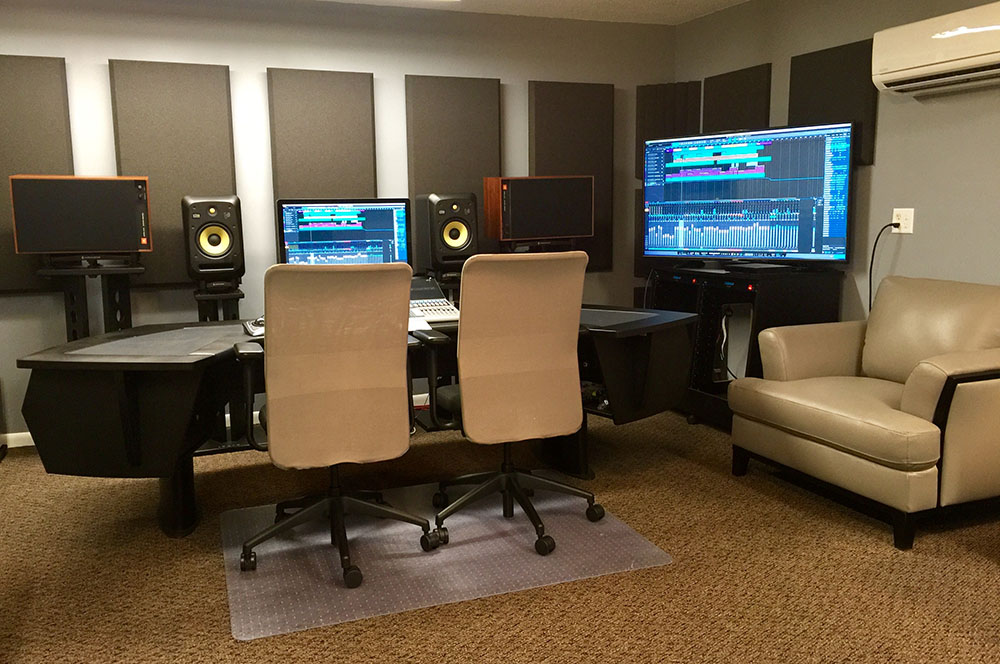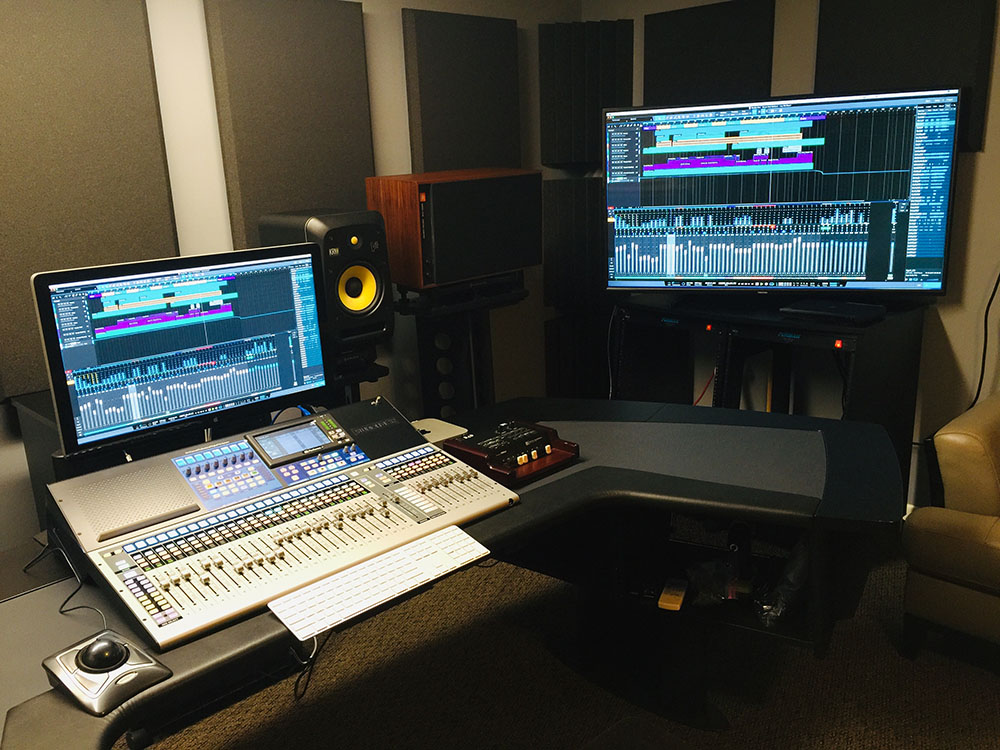Monthly Archives: April 2019
Justin Lassen on the Making of Black Fox Society: Abstract
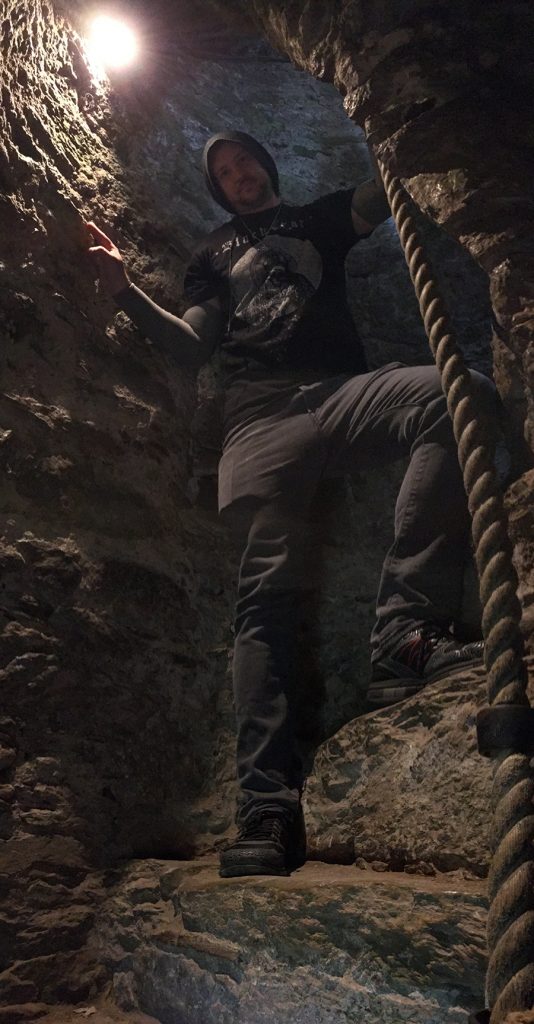
Justin Lassen is a composer, producer, sound designer, and good friend to PreSonus. Justin has had his hands in a LOT of music, TV, and video game projects over the years, but is perhaps best known for his best-selling sound library “White Rabbit Asylum.” Always one to outdo himself, Justin has followed it up with a spiritual successor called “Black Fox Society: Abstract,” available now at shop.presonus.com.
Let’s be clear from the get-go… this is not just another sound library. Justin spent ten years traveling to obscure corners of the earth to record strange and unheard sounds for this project, and then spent another year just editing them all together for this massive 3.7 gigabyte collection of loops, instrumentals, and industrial beats—all inspired by mysterious secret societies. He was kind enough to take the time to share some stories (and AMAZING photos!) of how this all came to be. Strap in, this one’s quite a ride.
Talk to us a little bit about some of the mysterious locations you went to—22+ countries is a LOT!
Secret societies have fascinated me for years. When I lived in Europe in my twenties, I became aware of so much history the world never hears about. Everything in these ancient cities is literally built on top of the previous generations. This means there are a lot of hidden spaces and forgotten stories to uncover. I knew that every country in the world has stories to tell, but I focused especially on the places that have shaped the world as we know it today.
I was drawn to places where I knew groups of influencers have gathered throughout time. So, I would start with plans to visit places that I knew would not only be visually intriguing but would also provide unique sound environments that could be crafted into high-quality ambient concepts. The most surprising part was what I would find along the way. As I talked to locals and explored some less-traveled roads, I found spaces that had a unique vibe, and I would stop and capture the environment before moving on.
Staying flexible in both my expectations of what I would actually capture, as well as where it would happen, allowed for some unexpected opportunities to capture some once-in-a-lifetime material.
For example, when I was in Korea, I received a tip from a local contact about a secret shamanic temple up in the mountains outside of the city. With very few people around, I was able to capture much of the mystical ambiance that was available among those sacred stones. Distant chanting and ceremonial bells enriched the environment more than I could have hoped.
In Europe, where so much history has been buried through the years, I made a point of going off the beaten path. This led me into ancient grottos, up decaying staircases, through ruins and forgotten graveyards full of nameless stones. You can’t be in these places without feeling something.
You might think that this is the magic behind Black Fox Society, but it’s these feelings that inspired me to take the recordings I collected around the world and shape them into individual works of art that evoke specific emotions, reminders of what I felt in these places.
What sort of field recording gear did you use?
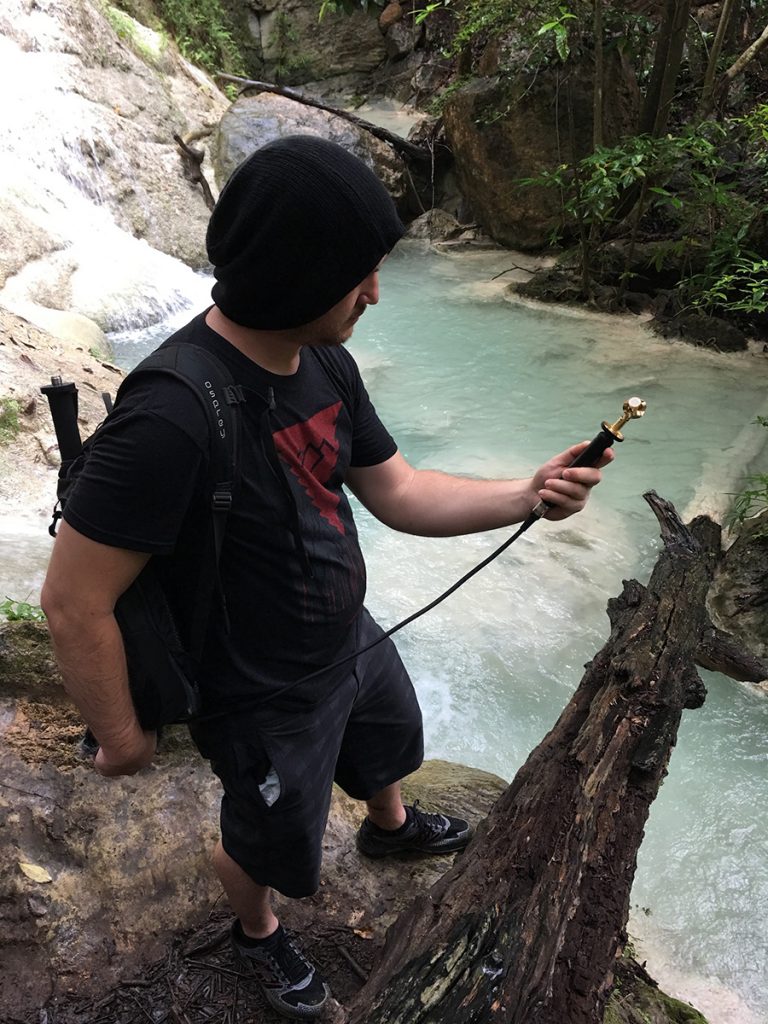
My primary field recording equipment was Zoom F4, Sennheiser Ambeo-VR Mic, and a Roland R-07 Recorder w/ Roland binaural headset/mic combo. I also brought a Netbook on my trip, several hard drives, and a ton of SD cards for the various recorders and camera equipment. I also used the Sennheiser Ambeo Smart Headset for some cool unique recording situations.
Any fave mics, recorders, etc? Binaural mics?
With all of that gear, and using all of it in each country and location, what ended up being my favorite piece of gear was the Ambeo Smart HeadSet, particularly when going into places that I wasn’t able to bring all of the mics, XLR cables, recorders. It ended up capturing some really beautiful audio that felt “3D” and even made me feel like I was “there” on playback. Upon returning from my trip, I actually got a ton of new equipment and microphones that I plan on bringing with me on my next set of adventures.
How do you keep such a huge collection of .WAV files organized when you’re busy traveling? One SD Card per location? Strict file naming conventions?
Keeping the files organized is easier than you might expect. I was walking an average of 10 miles per day in most cities. I was usually pretty tired by the end of the day! It was a non-negotiable routine when I would get back to my computer to download the work from that day. I would organize it by city and by date. I kept a concise log of my itinerary, including notes of where I went and what I did that day. I organized the video, pictures, and drone footage the same way and that helped keep everything straight.
The most important thing to know about the file management is that at the end of the day, the project didn’t demand location-specific end products. Creating the library was a much more artistic venture than just a single track pulled from a cathedral in Prague, for example. Each ambient loop in the library has 8 to 17 layers in them, each layer coming from different parts of the trip and world. The color of each audio sample was more important than the locale in deciding how it would be used in the final content.
The file names were simple, based on date and city. My criteria for what was worth including was determined beforehand, so I didn’t need to filter my content much when I got back. I ended up using almost every single thing I recorded!
Did you have any issues getting all of that recording gear and media from country-to-country (through international customs) in your travels?
Yes, actually. I was at airports almost every other day, and no airport ever took it easy on me. I had to take everything out of its case, out of the bag each time, to show them that it wasn’t some elaborate mechanism. I even had to throw away batteries and things in some countries. I think the next time I do a trip like this I want to simplify the gear even more. What a lesson to learn. What is very good news is that recording equipment is getting smaller and smaller, even for ultra-high-definition audio. Taking the drone out of its case was also not fun at all. The 4K camera and gimbal system also looked strange on scanners, so that had to come out of the bag as well. I almost missed a few flights because of some of the security screenings taking longer than they should have. I’ll pack lighter next time… and I thought I was pretty light to begin with!
What were some challenging moments in the field and why?

Some of the most challenging moments for me was the physicality of this kind of immense travel. Walking 10 miles a day on foot, meant I needed shoes that would keep me alive and moving forward. A lot of people saw my Instagram during the travels and thought it looked like a fun trip and gorgeous photos and stories. Parts of it were fun, but most of it was insanely long hours and hard work. Not just the recording aspect, but moving from place to place, getting equipment out at the drop of a hat if we happened to venture upon something unplanned but totally interesting and worth capturing. A lot of this trip was filled with those surprise moments.
Other challenges included making sure we didn’t get lazy with organizing the content. At the end of each night, no matter how tired, I had to make sure to file things away, organize things on the hard drives (multiple hard drives for backup) from all the SD cards and recording equipment.
I got sick during parts of the trip, but still had to keep moving forward. I had a goal and a dream, and a lot of tickets booked. I couldn’t miss flights or trains or cars, even if I was sick, I had to venture forward and keep on schedule and on track. In a lot of ways, it’s like a band on tour. Band tours are hard and grueling work. You’re expected to perform in each city, and there is no “fun time,” as each day in between is only used to travel to the next set of destinations. I didn’t get to stop and rest very often at all if ever. Carrying an entire studio on my back, gear and everything as we walked was also hard work. My feet were sore, but I knew I had to get through all of these countries and try to find the best audio I could find. I made sure to do a lot of research in between travel to pick interesting places that fit the sounds and environments I was going after.
Did you discover any amazing new foods/dishes that were firsts?
We always ate the best food in each country in general, but one of my absolute favorite places to eat was Thailand! That country has some awesome food. In particular, I had the honor of feasting on the award-winning menu of Chef Bee Satongun (who was awarded Best Female Chef in Asia, 2018.) So pretty amazing and humbling to be eating dishes from one of the best of the best in all of Asia! Her food has so many flavors and textures that create little worlds of their own! She was an artist. She even let me bring recording equipment into her kitchen to capture foley design, sound design and ambiance while she was cooking and creating her masterpieces. We recorded all kinds of ambisonic stuff even with food! ?
How did the people and the countries’ overall vibe and energy affect your project sonically?

People always affect my creative process wherever I am in the world. Sonically, each group of humans spoke different languages, so that created a new ambiance wherever we went. Humans have different tonal qualities depending on the language they speak. If you add large groups of them together, you get very different textures in general. For crowds, trains, or cityscapes, it is the people, the human beings, with voices that bring those places to life. Night markets in Korea vs. day markets in Thailand or heavily touristed areas in Europe all had their own tones and chatter. Even different train tunnels and docks of people sounded different from place to place.
Each country also had its own general vibe and energy. Of all the places I went, I think I really loved Ireland the most. The people there were so warm, friendly and caring. Not to say that there aren’t warm and friendly people in other places, but for me, I felt right at home in Ireland. Driving through the countryside (on the wrong side of the road, haha) was beautiful to experience. It’s these kinds of vibes and energies that differ in all these places. The jungles in Thailand or even getting to play with an elephant in a river was one of my most memorable experiences. Yes, we recorded audio from my playtime with the elephant, but being near this beautiful creature had a pure energy around it that I will remember until the day I die. I got to do so many things and meet so many people that it will be years of stories that I can recall for years to come!
OK, let’s not forget that getting there is only HALF the fun. You spent a year editing this stuff together, so here’s some post-production questions:
Any particular tricks or processing that came in particularly handy?
I love the “markers” in Studio One, especially when “exporting”, it makes cataloging and batch exporting so much easier for one-shots and custom sound design layers. I didn’t want to just make a generic “found sound” kind of library, so I did a lot of editing, manipulation and huge chains of plugins to process and change the audio for some of the layers. I wanted to maintain the realism of the raw samples and augment them with stories and sonic ideas. However, I still wanted to maintain the vibe of the places I visited. I collected my own impulse responses (IR) when I could in certain places, and then used those to further edit location audio in other places, to create an amalgamation of different textures and moods. Like taking the reverb IR from a cathedral in one country and using it to process the outdoor space of a jungle or a cave and so on. There were no “rules.” I didn’t want to give myself any barriers. I wasn’t making a “documentary” about world travel. I was telling a story about secret places and societies. I was using the sounds I found all over the world simply as colors, that I could dip into and paint new landscapes and seemingly otherworldly places to explore. My body explored these places on the trip, but my mind further explored these places back home in the studio on a deeper level.
I love being able to collect the spirit of a place or situation and go for hyper-realism in some situations and majestic imagination in others. That is my favorite thing about sound design and audio editing. Every sample, every foley design, every hit, every texture, every ambient space can be broken apart and put back together in a million different ways like lego bricks. Although I have a pretty generously-sized library that I released, the trip still has over five terabytes of raw audio collected as a well of inspiration for future dreams and future projects to come. It was an amazing journey. I felt like Indiana Jones in some places.
You mention that Black Fox Society is ideal for use in VR and games. What are some of the considerations made in the tracking phase as opposed to recording sounds for traditional stereo use? 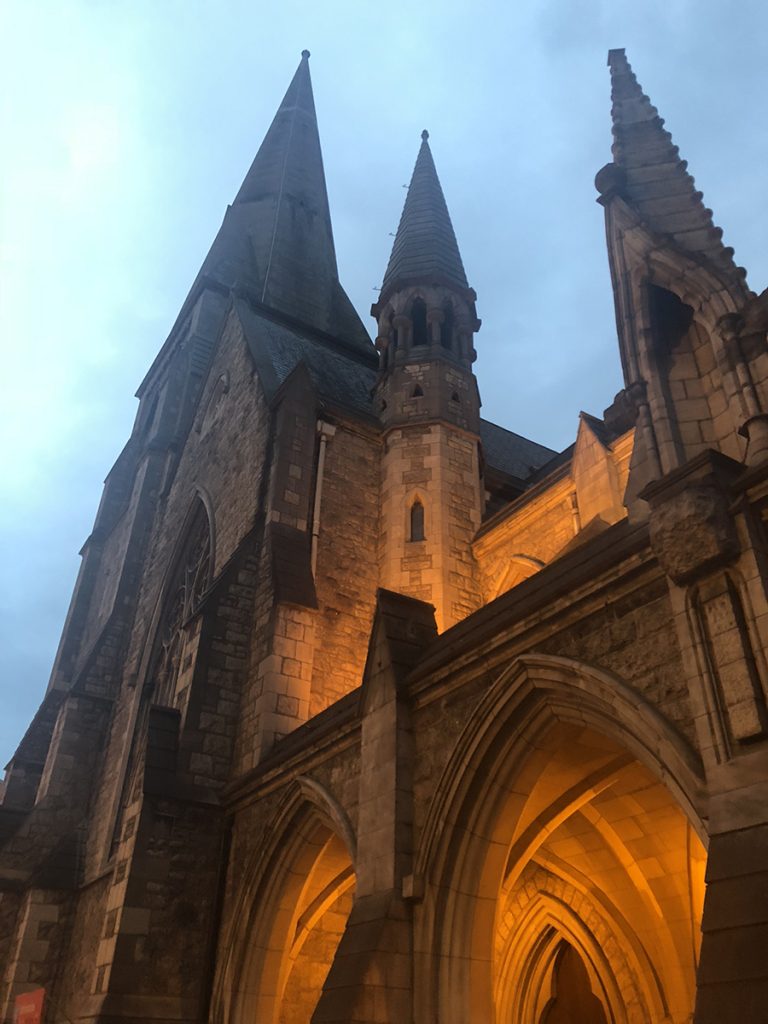
I work in Unreal and Unity engines a lot on the games that I get to work on, so I’ve had years of experience in implementing audio assets into interactive programs, attractions, rides, video games and virtual reality experiences, including the 2018 Emmy-nominated Spider-Man VR Experience which I was Audio Director for. I have been getting more heavily involved with surround audio in the last half decade, more-so than any time in my career—although I started doing surround remixing and composing with DTS back in 2004! For Black Fox Society to be useful for me as a sound designer for these kinds of experiences, I wanted to make sure that the audio felt “spatial” and like I’m “there.”The more spatial, the more useful for me and other sound designers in these fields.
I made sure to collect a lot of 3D audio/binaural audio, particularly because it can translate well for video games, VR, trailers, and movies alike. Ambisonic audio is great because you can collapse it down to a binaural field with very straightforward plugins. I relied heavily on environmental captures, impulse responses, and natural spatial audio in the places I traveled. I made sure to sit still and collect several minutes of each place I visited and cut out the most useful parts and augment with other audio captures to create little audio paintings. I didn’t want a “generic” library with no soul, so I made sure to mix and match different environments together to create the illusion of new places and new worlds (and new stories, as you can tell from the titles that evoke interesting emotions!) That was my favorite part of all of this sound design. I wanted to make a plethora of useful ambient audio that could be used in a number of different scenarios and still feel fresh to each new sound designer working on their own projects.
How did this library differ for you in terms of the workflow process, compared to say… White Rabbit Asylum?
White Rabbit Asylum was a more drawn-out casual creation process. It was collected over a decade from any kind of recorder I had on me at the time. From really bad microphones to really good ones and everything in between (cell phones, tape recorders, (yes, tape!) cameras, early generation portable recorders, etc.) White Rabbit Asylum did not have binaural audio or surround audio. It was merely a collection of interesting audio from my travels and adventures around the world at that time in my life. It was like a photograph or snapshot of where I was in that time of my life. White Rabbit Asylum was never meant to be a “library,” it sort of just happened naturally and organically over time from an enormous amount of collected and recorded audio. I was approached by Sony to release it as a “library,” so I edited and composed some interesting loops and story ideas with all that audio and created a haunted, surreal, otherworldly vibe with that collection. I wanted to make a library that I would want to use as well. I’m very proud of it to this day as a piece of my history.

Black Fox Society is a more deliberate approach. I traveled the world knowing I would eventually create a new library from the content I collected and recorded. It’s a spiritual successor for sure. Almost five years ago my friend Jim and I met in Louisiana and found that he was a fan and user of my previous library. He and many others have asked me over the years “When are you going to create another library?” I never quite had an answer for that because I was always busy working on so many different kinds of projects. I was doing a lot of pioneering surround work, 3D audio, binaural and ambisonic audio for Virtual Reality immersive experiential attractions and projects in these new industries. I was going out and collecting new audio for each new project, one at a time. Designing stuff from the ground up from scratch. Very tedious.
There aren’t a lot of libraries on the market with ready-to-go loopable immersive audio, so I wanted to put in a lot of hard work and heart and soul into this library so that not only would I want to use it but it might inspire others to use it for their own dreams and visions too. I wanted to create a library that could help not only me, but other VR producers and sound designers, attraction designers, film and video game editors fall into these beautiful sonic worlds. I hope that this inspires a bunch of new experiences and immersive stories for years to come. I especially love how all the layers work together in different ways for different moods and feelings.
More from Justin:
- Buy Black Fox Society: Abstract
- Sampling Surround Sound and Binaural Audio for Use in Virtual Environments and Games (via Intel)
- SoundCloud
PreSonus Fam Friday with Peyton McMahon
It’s that time again… PreSonus Fam Friday!
Introducing one of the newest and most talented members to the PreSonus team—Peyton McMahon! Not only is he super-rad addition to the team, he’s a hard-working singer-songwriter and PreSonus user! Random fact: Once he performed alongside the ORIGINAL American Idol, Kelly Clarkson at one of her shows. Get to know Peyton here and check out his latest single out today!
How long have you worked for PreSonus?
I’ve been here six months.
What’s your official job title?
Inside Sales Coordinator.
What’s your favorite thing about your job? Why did you choose to work here
I love getting to learn more about both studio and live equipment. As an artist, it has been super beneficial for me to get more educated on this stuff and it’s going to serve me well in the future! That’s one of the main reasons I chose to work here, it is helpful to my craft.
What was the first 8 track, cassette, CD or digital download you purchased?
Middle of Nowhere by Hanson when I was 5. ZERO shame. (And FYI, those guys are ridiculously talented and still put out some great music.)
Who’s your go-to band or artist when you can’t decide on something to listen to?
It totally depends and changes often, but lately it’s been James Bay. He’s got a great variety of stuff that always levels out my mood, and I love his voice.
What’s your go-to Karaoke song?
If I’m ever doing karaoke, it’s probably been a long night of drinking, I have to have someone up there with me, and I never try to be serious with it… It usually ends up being “Hello,” by Lionel Richie, “Since U Been Gone,” by Kelly Clarkson, or “Hero” from the Spiderman soundtrack.
Everyone has a side gig, what’s yours? OR when you’re not at PreSonus, what are you up to?
I’m a pop/rock singer/songwriter, so I’m always doing the typical aspiring artist hustle… Writing, recording, playing gigs, researching, online stuff, etc.
What instruments do you play? What do you love about them?
I play guitar, piano, and I sing. I love both guitar and piano because they’re so easy to sit down and write songs with. Starting with just piano/guitar and vocals is all you need to get down the base of the song, and the possibilities from there production-wise are limitless.
Why did you choose this as your favorite?
I love the Eris 3.5s because they’re such great quality sound for such a great price and easy size. They’re also versatile… Great for both elevating your everyday music listening as well as listening to mixes for music you might be working on.
What are you currently working on at PreSonus? What’s next for you?
Releasing and promoting my new single, out TODAY, and continuing to write and record my upcoming EP!
What’s the strangest talent you have?
I have a really weird knack for remembering vivid details in memories. Like, I can remember specific dates and details for memories in my life, down to what I and others were wearing.
Anything else you want to share?
I have a new single out TODAY called “Liberate Me,” and y’all should check it out on Spotify/Apple Music/wherever you listen to music!
-
Follow Peyton on Instagram here!
-
Grab you a pair of the Eris 3.5s here!
-
Check out Peyton performing at a Kelly Clarkson show
Friday Tips: How to Normalize Comped Takes
Comping’s goal is to piece together the best parts of multiple Takes (vocals, guitar, etc.) into a single, cohesive part. This involves Studio One’s loop recording, which repeats a section of music over and over during a looped section. You record another Take during each pass, while previous Takes are muted. Doing multiple takes without having to stop lets you get comfortable, and try different approaches. Once you have multiple versions, you audition and select the best sections.
However, when auditioning the Takes to decide which sections are best, it’s helpful to compare levels that are as similar as possible. Normalization is the right tool for this—but while it’s not yet possible to normalize individual Takes, there’s a simple solution.
- Right-click on the main, parent Track for the Takes and choose Unpack Layers to Tracks (Fig. 1).

Figure 1: The four Takes right immediately below the parent vocal have been unpacked into four Tracks (color-coded blue).
- Next, select all the audio in the new Tracks.
- Type Ctrl+B and then Alt+N. This normalizes all the Tracks.
- Right-click on each Take’s audio and choose Delete (do not delete the Take itself; see Fig. 2).
- Select the audio in the new Tracks.
- Drag the audio from the new Tracks up, so that they replace where the Takes were (Fig. 3).
- The empty Tracks are no longer needed, so remove them.
- And that’s all there is to it—now you can take advantage of Studio One’s Take-oriented comping tools, as well as the Listen tool (keyboard shortcut 8), with normalized audio.
PreSonus Weekend Rundown
It’s been a busy week. Let’s rehash the important stuff you may have missed.
This is a fun one going on with our friends at Splice. Mix “Nobody’s Gonna Love You” into a radio-ready track to win hardware and software from us, the Mixing University course from Recording Revolution, an Eyeball microphone cover, and a call with Briana Tyson.
Friday Tips: The Center Stage Reverb
If you’ve ever played a large venue like a sports arena, you know that reverb is a completely different animal than what the audience hears. You hear your instrument primarily, and in the spaces between your playing, you hear the reverb coming back at you from the reflections. It might seem that reverb pre-delay would produce the same kind of effect, but it doesn’t “bloom” the way reverb does when you’re center stage in a big acoustical space.
This week’s tip is inspired by the center stage sound, but taken further. The heart of the effect is the Expander, but unlike last week’s Expander-based Dynamic Brightener tip, the Expander is in Duck mode, and fed by a sidechain. Here’s the Console setup.
In the audio example, the source is a funk guitar loop from the PreSonus loop collection; but any audio with spaces in between the notes or chords works well, especially drums (if the cymbals aren’t happening a lot), vocals that aren’t overly sustained, percussion, and the like. I deliberately exaggerated the effect to get the point across, so you might want to be a little more tasteful when you apply this to your own music. Or maybe not…
The guitar’s channel has two sends. One goes to the FX Channel, which has a Room Reverb followed by an Expander. The second send goes to the Expander’s sidechain input. Both are set pre-fader so that you can turn down the main guitar sound by bringing down its fader, and that way, you can hear only the processed sound. This makes it easier to edit the following Room Reverb and Expander settings, which are a suggested point of departure. Remember to enable the Expander’s Sidechain button in the header, and click the Duck button.
The reverb time is long—almost six seconds. This is because we want it going constantly in the background, so that after the Expander finishes ducking the reverb sound, there’s plenty of reverb available to fill in the spaces.
To tweak the settings, turn down the main guitar channel so you can monitor only the processed sound. The Expander’s Threshold knob determines how much you want the reverb to go away when the instrument audio is happening. But really, there are no “wrong” settings—start with the parameters above, play around, and listen to what happens.
This is a pretty fertile field for experimentation…as the following audio example illustrates. The first part is the guitar and the reverb effect; the reverb tail shows just how long the reverb time setting is. The second part is the reverb effect in isolation, processed sound only, and without the reverb tail.
This is a whole different type of reverb effect—have fun discovering what it can do for you!
Introducing the SPARK Collections!
 Introducing the SPARK Collections!
Introducing the SPARK Collections!
Hit the ground running with the new Spark Collection of loops and add-ons from PreSonus! These low-priced loop packs are a great place to start making music for less. These professional, royalty-free tracks are a great source of inspiration for starting a new song, learning how to mix, or adding a little flavor to your existing compositions. We’ve launched Spark Collections with a whopping 35 packs… with many more to come!
Everything from trap, reggae, pop, and sound FX are available in the Spark Collections – for just $4.95 USD each!
Click here to shop Spark Collections on shop.presonus.com!
PreSonus Symphonic Orchestra has been updated
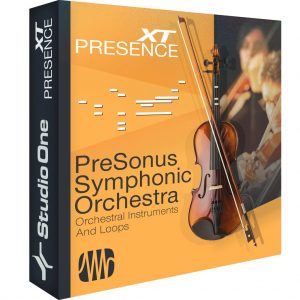
- key switch assignment in “Orchestral FX KS”, “Orchestral Tuba”, “Tenor Trombone”, “Japanese Bowles”, “Temple Blocks”
- sample mapping in “Harp FX”, “Strings FX”, “Trumpet FX”, “Celli FX”, “Brass FX”, “Flute FX”, “Orchestral FX KS”,
- round robin volume inconsistencies in “Viola – Staccato”
- loop points to “Viola – Arpeggios” (major, minor, diminished)
- layer and release sample volume in “Viola Section”: Staccato, Tremolo, Trill HS, WS
- wrong key switch removed in “Viola Section”: Trill WS
- loop activated in “Viola Section”: Arpeggio minor/major
- layer gain in “Big String Section – Staccato”
- sample start points in “Bass Section – Pizzicato”, “Bass Section KS”
- Uninstall PSO Contemporary Strings.soundset and PSO Classic Orchestra.soundset via the Studio One Browser:
- Go to the browser file tab
- Open the Sound Sets folder in the root
- Locate the Sound Sets mentioned above
- Right-click on the Sound Sets and select “Uninstall”
- Install the new versions:
- In the application menu, select “Studio One Installation…”
- In “My Purchased Items” select the two new Sound Sets of the same name
- Click “Install”
Via web browser:
- Go to my.presonus.com and log into your MyPresonus account
- Go to My Products > Add-Ons
- Locate PreSonus Symphonic Orchestra and click “View more details”
- Download the two new Sound Sets (PSO Contemporary Strings and PSO Classic Orchestra)
- When download is complete, drag the new Sound Sets into the Studio One application window while running
Friday Tips: The Dynamic Brightener for Guitar
When you play an acoustic guitar harder, it not only gets louder, but brighter. Dry, electric guitar doesn’t have that quality…by comparison, the electrified sound by itself is somewhat lifeless. But I’m not here to be negative! Let’s look at a solution that can give your dry electric guitar some more acoustic-like qualities.
How It Works
Create an FX Channel, and add a pre-fader Send to it from your electric guitar track. The FX Channel has an Expander followed by the Pro EQ. The process works by editing the Expander settings so that it passes only the peaks of your playing. Those peaks then pass through a Pro EQ, set for a bass rolloff and a high frequency boost. Therefore, only the peaks become brighter. Here’s the Console setup.
The reason for creating a pre-fader send from the guitar track is so that you can bring the guitar fader down, and monitor only the FX Channel as you adjust the settings for the Expander and Pro EQ. The Expander parameter values are rather critical, because you want to grab only the peaks, and expand the rest of the guitar signal downward. The following settings are a good point of departure, assuming the guitar track’s peaks hit close to 0.
The most important edit you’ll need to make is to the Expander’s Threshold. After it grabs only the peaks, then experiment with the Range and Ratio controls to obtain the sound you want. Finally, choose a balance of the guitar track and the brightener effect from the FX Channel.
The audio example gets the point across. It consists of guitar and drums, because having the drums in the mix underscores how the dynamically brightened guitar can “speak” better in a track. The first five measures are the guitar with the brightener, the next five measures are the guitar without the brightener, and the final five measures are the brightener channel sound only. You may be surprised at how little of the brightener is needed to make a big difference to the overall guitar sound.
Also, try this on acoustic guitar when you want the guitar to really shine through a mix. Hey, there’s nothing wrong with shedding a little brightness on the situation!
Glenn Rosenstein on the FaderPort 16 and and the StudioLive Ecosystem
This just in from Glenn Rosenstein, a three-time Grammy-winning mix engineer whose credits include U2, Madonna, Talking Heads, The Ramones, James Brown, Miles Davis and many others. His work in film and television has landed him both an Oscar and a Golden Globe while working on projects including The Sopranos, Celebrity Circus, The Last Emperor, Blown Away, Married To The Mob, Charmed, Beverly Hills 90210, All My Children and Buffy The Vampire Slayer. We recently got in touch with him to get his perspective on all things PreSonus.
Hey Glenn. Tell us about yourself!
I’ve had a fun career that’s led me to many musical adventures. I started early on at Power Station in NYC, then as a staff engineer at Sigma Sound Studio. I became an independent mixer, then producer, eventually winning some Grammys and selling a bunch of records, back when that was a possibility. I’m still producing both for my Sony labels, as well as independently. I partner in a number of project studios in Nashville, Muscle Shoals, and New York, as well as having a room at historic Fame Studios.
What PreSonus products have you used and which do you currently use?
I’ve always been a PreSonus user. As time goes on, PreSonus continues to release products that almost anticipate my needs. I started out with the ADL 600, a very tasty stereo mic pre from a few years back. I’ve put together a pretty cool room in my Muscle Shoals facility that’s centered around the StudioLive 64S, along with some great AVB powered PreSonus peripherals: The StudioLive 32R, the EarMix 16M, and the SW5E among them. Also to be found are the PreSonus R80 monitors and, of course, Studio One. And I always travel with my Faderport 16. Always.
For what applications are you using the products?
My PreSonus facility is very much a writing/production room that is easily convertible to a full-blown production studio. I like the creative ease and intuitive design that is integrated into all of the PreSonus cosmos of products. It’s simple to start off small—just creating some beats or a few phrases on guitar or a vocal idea—and easily push that to a bigger, more robust production without having to shift rigs.
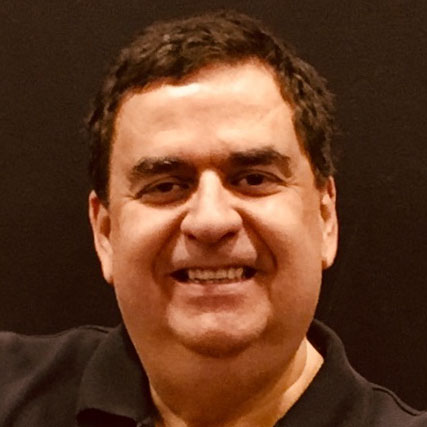
What led you to choose these particular PreSonus products?
I had a pretty solid awareness of the PreSonus offerings for many years and was fortunate enough to meet and spend some time with Jim Odom. His backstory is steeped in music production and performance, and, ultimately, creating solutions that he wanted for himself. I liked that a lot. I still do. I totally get the narrative of PreSonus products, their evolution over the past few years, and their remarkable value. Jim and his team are always pushing the boundaries—they’re taking insane amounts of features and options and putting them in boxes that should cost five times what they’re asking. I have no idea how they get it done, but they do. And all that filters down into very usable tools that sound great and are fun to work with.
Having used the gear, what do you like most about the specific PreSonus products you use?
Let’s talk about the Faderport 16: A 16-channel control surface that fits under your arm—brilliant design and execution. Regardless of my preferred DAW, I always feel right at home. I’m in a hotel, it’s there. I’m in a rehearsal room, it’s there. Perfect combination of small footprint and functionality.
Mixing Competition with Recording Revolution, Splice, and Briana Tyson
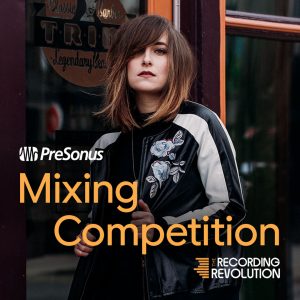 We’ve partnered with Splice, The Recording Revolution, and Briana Tyson for a mixing competition!
We’ve partnered with Splice, The Recording Revolution, and Briana Tyson for a mixing competition!
Practice your chops bringing stems from Briana to life and share your best mixing tips and tricks with the rest of the community! Here’s how it works. Click the link below to visit Splice and download the project files and stems for Once all the mixes are in, Graham from Recording Revolution will listen through the mixes and choose the one he thinks is radio ready to win his premiere mixing course Mixing University, a pair of Eris E66 Monitors and a copy of Studio One 4 Professional, an Eyeball microphone cover from Kaotica, a video call with Briana Tyson, and consideration from Briana Tyson for official release!
Click here to learn more and sign up!


